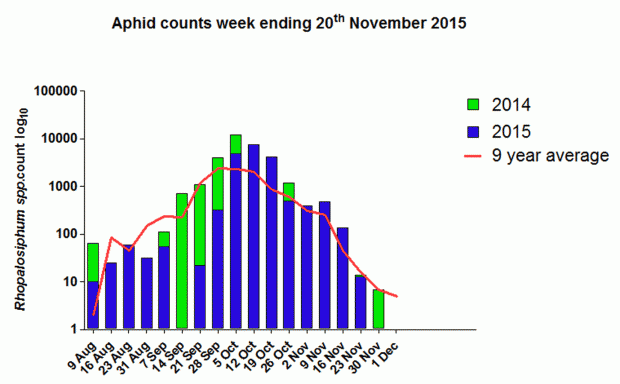Aphid count for Northern Ireland

Points to note
- log10-scale for aphid counts
- Weekly cereal monitor – overall, autumn aphid migration activity effectively concluded
- We anticipate one further collection to confirm and complete the dataset
- thank you for your interest in this work
There are two types of bird cherry-oat aphid:
- one over winters exclusively as eggs on bird cherry trees, but does not spread BYDV to cereals
- the other colonises grasses or cereals all year round and reproduces without mating, spreading the virus throughout the autumn and winter as weather conditions allow
The grain aphid survives on grasses and cereals throughout the year, persisting longer during the winter as it is more frost hardy then the bird cherry aphid. It rarely lays eggs but reproduces without mating.
How is BYDV transmitted?
The aphids transmit BYDV into winter cereals by two ways:
- cereal volunteers, or grass weeds within a field can act as hosts for aphids after stubble destruction. This type of infection typically causes large discrete patches of severely infected plants
- winged aphids flying from grass or cereal volunteers elsewhere can also introduce the virus into the newly emerged crops during the autumn. This is the most common route for BYDV infection
Risk forecasting
The Aphid Migration graph provides an indication of aphid numbers in Northern Ireland and consequently the risk of BYDV. This data is collected and updated weekly by Science Service Newforge Lane during the high-risk autumn period. The current situation is displayed against a reference “10 year average” to indicate whether the aphid numbers are significantly higher than usual. This is used to assess the degree of risk of BYDV infection in conjunction with the emergence dates of winter cereal crops. The advice based on this assessment could be:
High risk
A large early migration of aphid vectors in conjunction with early emergence of crops. Action: Application of insecticidal spray to crops which have reached the 2-leaf stage of growth. This should be followed up after 2 weeks with a crop inspection for further aphid arrivals.
Moderate risk
Migration at or slightly higher than the 10 year average and crops emerging later. Action: Application of insecticidal spray to crops (2-leaf stage) emerged before the end of the aphid migration (usually early November)
Low risk
Migration below the 10 year average. Action: Monitor crops regularly for presence of aphid vectors. Application of insecticidal spray only to those crops where aphids are found.
Aerial introduction of BYDV by migrating aphids results in point infections scattered throughout the crop. The real damage is caused when these initial aphids give rise to colonies which disperse and carry the infection to surrounding plants. Insecticidal sprays are used to limit this spread of BYDV so that the overall level of infection is insignificant when the crop matures.
BYDV control
Cereal aphid monitoring for autumn 2014 has commenced. The Aphid Migration graph provides an indication of aphid numbers in Northern Ireland and consequently the risk of BYDV. During the high-risk autumn period this data is collected and updated weekly by Science Service Newforge Lane. To view the updated reports and for more information click the link to BYDV control down the left side of this page.
- in situations where there is a weedy stubble or a large number of volunteers cereal plants, this "green bridge" should be destroyed by desiccation with paraquat or glyphosate 7-10 days before ploughing and in an interval of a least 14 days allowed before sowing
- for drilled crops an aphicide approved for BYDV vector control can be applied at the 2-3 leaf growth stage
- seed treatment-containing clothianidin, e.g. Redigo Deter, can provide protection from BYDV in the weeks immediately after sowing. If low seed rates are used or the crop is early sow, an additional aphicide application may be required
Growers should check the product label for full details.
